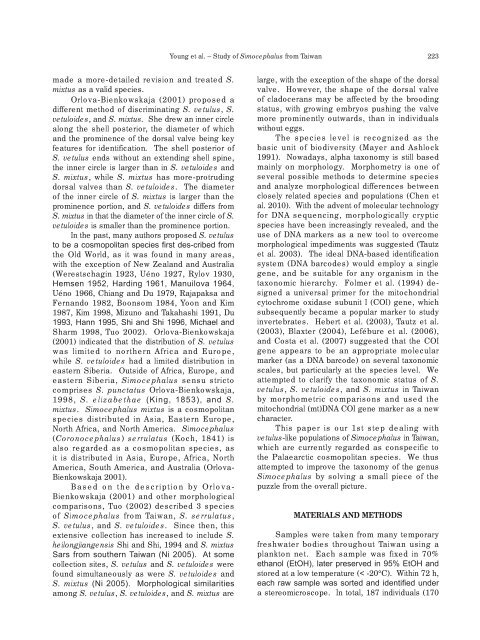Download PDF - Zoological Studies - Academia Sinica
Download PDF - Zoological Studies - Academia Sinica
Download PDF - Zoological Studies - Academia Sinica
You also want an ePaper? Increase the reach of your titles
YUMPU automatically turns print PDFs into web optimized ePapers that Google loves.
Young et al. – Study of Simocephalus from Taiwan 223<br />
made a more-detailed revision and treated S.<br />
mixtus as a valid species.<br />
Orlova-Bienkowskaja (2001) proposed a<br />
different method of discriminating S. vetulus, S.<br />
vetuloides, and S. mixtus. She drew an inner circle<br />
along the shell posterior, the diameter of which<br />
and the prominence of the dorsal valve being key<br />
features for identification. The shell posterior of<br />
S. vetulus ends without an extending shell spine,<br />
the inner circle is larger than in S. vetuloides and<br />
S. mixtus, while S. mixtus has more-protruding<br />
dorsal valves than S. vetuloides. The diameter<br />
of the inner circle of S. mixtus is larger than the<br />
prominence portion, and S. vetuloides differs from<br />
S. mixtus in that the diameter of the inner circle of S.<br />
vetuloides is smaller than the prominence portion.<br />
In the past, many authors proposed S. vetulus<br />
to be a cosmopolitan species first des-cribed from<br />
the Old World, as it was found in many areas,<br />
with the exception of New Zealand and Australia<br />
(Werestschagin 1923, Uéno 1927, Rylov 1930,<br />
Hemsen 1952, Harding 1961, Manuilova 1964,<br />
Uéno 1966, Chiang and Du 1979, Rajapaksa and<br />
Fernando 1982, Boonsom 1984, Yoon and Kim<br />
1987, Kim 1998, Mizuno and Takahashi 1991, Du<br />
1993, Hann 1995, Shi and Shi 1996, Michael and<br />
Sharm 1998, Tuo 2002). Orlova-Bienkowskaja<br />
(2001) indicated that the distribution of S. vetulus<br />
was limited to northern Africa and Europe,<br />
while S. vetuloides had a limited distribution in<br />
eastern Siberia. Outside of Africa, Europe, and<br />
eastern Siberia, Simocephalus sensu stricto<br />
comprises S. punctatus Orlova-Bienkowskaja,<br />
1998, S. elizabethae (King, 1853), and S.<br />
mixtus. Simocephalus mixtus is a cosmopolitan<br />
species distributed in Asia, Eastern Europe,<br />
North Africa, and North America. Simocephalus<br />
(Coronocephalus) serrulatus (Koch, 1841) is<br />
also regarded as a cosmopolitan species, as<br />
it is distributed in Asia, Europe, Africa, North<br />
America, South America, and Australia (Orlova-<br />
Bienkowskaja 2001).<br />
Based on the description by Orlova-<br />
Bienkowskaja (2001) and other morphological<br />
comparisons, Tuo (2002) described 3 species<br />
of Simocephalus from Taiwan, S. serrulatus,<br />
S. vetulus, and S. vetuloides. Since then, this<br />
extensive collection has increased to include S.<br />
heilongjiangensis Shi and Shi, 1994 and S. mixtus<br />
Sars from southern Taiwan (Ni 2005). At some<br />
collection sites, S. vetulus and S. vetuloides were<br />
found simultaneously as were S. vetuloides and<br />
S. mixtus (Ni 2005). Morphological similarities<br />
among S. vetulus, S. vetuloides, and S. mixtus are<br />
large, with the exception of the shape of the dorsal<br />
valve. However, the shape of the dorsal valve<br />
of cladocerans may be affected by the brooding<br />
status, with growing embryos pushing the valve<br />
more prominently outwards, than in individuals<br />
without eggs.<br />
The species level is recognized as the<br />
basic unit of biodiversity (Mayer and Ashlock<br />
1991). Nowadays, alpha taxonomy is still based<br />
mainly on morphology. Morphometry is one of<br />
several possible methods to determine species<br />
and analyze morphological differences between<br />
closely related species and populations (Chen et<br />
al. 2010). With the advent of molecular technology<br />
for DNA sequencing, morphologically cryptic<br />
species have been increasingly revealed, and the<br />
use of DNA markers as a new tool to overcome<br />
morphological impediments was suggested (Tautz<br />
et al. 2003). The ideal DNA-based identification<br />
system (DNA barcodes) would employ a single<br />
gene, and be suitable for any organism in the<br />
taxonomic hierarchy. Folmer et al. (1994) designed<br />
a universal primer for the mitochondrial<br />
cytochrome oxidase subunit I (COI) gene, which<br />
subsequently became a popular marker to study<br />
invertebrates. Hebert et al. (2003), Tautz et al.<br />
(2003), Blaxter (2004), Lefébure et al. (2006),<br />
and Costa et al. (2007) suggested that the COI<br />
gene appears to be an appropriate molecular<br />
marker (as a DNA barcode) on several taxonomic<br />
scales, but particularly at the species level. We<br />
attempted to clarify the taxonomic status of S.<br />
vetulus, S. vetuloides, and S. mixtus in Taiwan<br />
by morphometric comparisons and used the<br />
mitochondrial (mt)DNA COI gene marker as a new<br />
character.<br />
This paper is our 1st step dealing with<br />
vetulus-like populations of Simocephalus in Taiwan,<br />
which are currently regarded as conspecific to<br />
the Palaearctic cosmopolitan species. We thus<br />
attempted to improve the taxonomy of the genus<br />
Simocephalus by solving a small piece of the<br />
puzzle from the overall picture.<br />
MATERIALS AND METHODS<br />
Samples were taken from many temporary<br />
freshwater bodies throughout Taiwan using a<br />
plankton net. Each sample was fixed in 70%<br />
ethanol (EtOH), later preserved in 95% EtOH and<br />
stored at a low temperature (< -20°C). Within 72 h,<br />
each raw sample was sorted and identified under<br />
a stereomicroscope. In total, 187 individuals (170

















